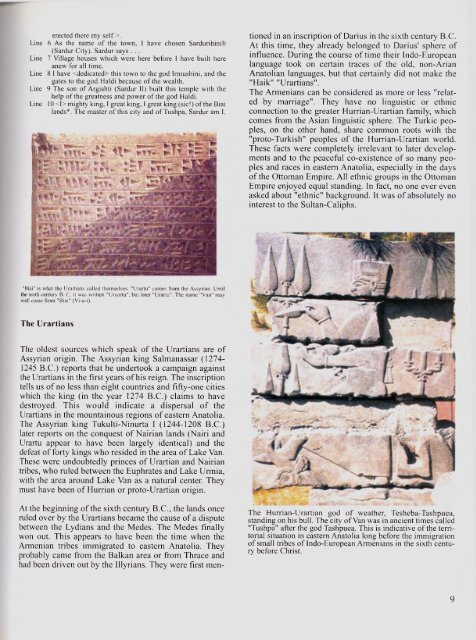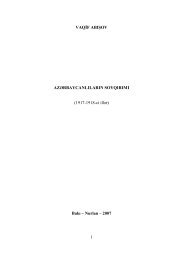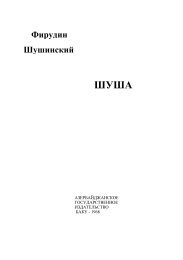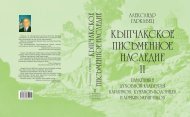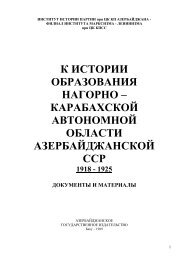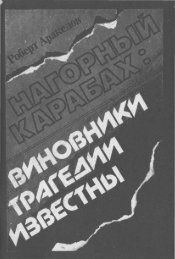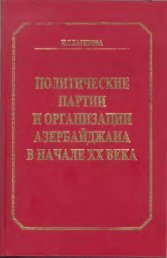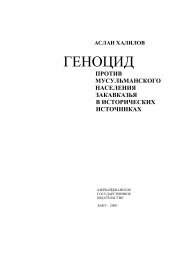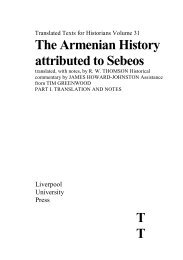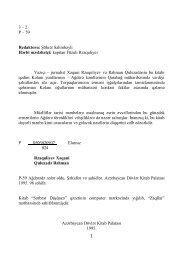ARMENIAN - Erevangala500
ARMENIAN - Erevangala500
ARMENIAN - Erevangala500
You also want an ePaper? Increase the reach of your titles
YUMPU automatically turns print PDFs into web optimized ePapers that Google loves.
erected there my self >.<br />
Line 6 As the name of the town, I have chosen Sardurihinili<br />
(Sardur City). Sardur says . . .<br />
Line 7 Village houses which were here before 1 have built here<br />
anew for all time.<br />
Line 8 I have this town to the god Irmushini, and the<br />
gates to the god Haldi because of the wealth.<br />
Line 9 The son of Argishti (Sardur 11) built this temple with the<br />
help of the greatness and power of the god Haldi.<br />
Line 10 mighty king, I great king, I great king (sic!) of the Biai<br />
lands*. The master of this city and of Tushpa, Sardur am I.<br />
"Biai" is what the Urartians called them selves. "Urartu" com es from the Assyrian. Until<br />
the tenth century В. C , it was written "Uruartu", but later "Urartu". The name "V an" may<br />
well come from "B ia i" (V i-a-i).<br />
The Urartians<br />
The oldest sources which speak of the Urartians are of<br />
Assyrian origin. The Assyrian king Salmanassar (1274-<br />
1245 B.C.) reports that he undertook a campaign against<br />
the Urartians in the first years of his reign. The inscription<br />
tells us of no less than eight countries and fifty-one cities<br />
which the king (in the year 1274 B.C.) claims to have<br />
destroyed. This would indicate a dispersal o f the<br />
Urartians in the mountainous regions of eastern Anatolia.<br />
The Assyrian king Tukulti-Ninurta 1 (1244-1208 B.C.)<br />
later reports on the conquest of Nairian lands (Nairi and<br />
Urartu appear to have been largely identical) and the<br />
defeat of forty kings who resided in the area of Lake Van.<br />
These were undoubtedly princes o f Urartian and Nairian<br />
tribes, who ruled between the Euphrates and Lake Urmia,<br />
with the area around Lake Van as a natural center. They<br />
must have been of Hurrian or proto-Urartian origin.<br />
At the beginning of the sixth century B.C., the lands once<br />
ruled over by the Urartians became the cause of a dispute<br />
between the Lydians and the Medes. The Medes finally<br />
won out. This appears to have been the time when the<br />
Armenian tribes immigrated to eastern Anatolia. They<br />
probably came from the Balkan area or from Thrace and<br />
had been driven out by the Illyrians. They were first men<br />
tioned in an inscription of Darius in the sixth century B.C.<br />
At this time, they already belonged to Darius' sphere of<br />
influence. During the course of time their Indo-European<br />
language took on certain traces of the old, non-Arian<br />
Anatolian languages, but that certainly did not make the<br />
"Haik" "Urartians".<br />
The Armenians can be considered as more or less "related<br />
by marriage". They have no linguistic or ethnic<br />
connection to the greater Hurrian-Urartian family, which<br />
comes from the Asian linguistic sphere. The Turkic peoples,<br />
on the other hand, share common roots with the<br />
"proto-Turkish" peoples of the Hurrian-Urartian world.<br />
These facts were completely irrelevant to later developments<br />
and to the peaceful co-existence o f so many peoples<br />
and races in eastern Anatolia, especially in the days<br />
o f the Ottoman Empire. All ethnic groups in the Ottoman<br />
Empire enjoyed equal standing. In fact, no one ever even<br />
asked about "ethnic" background. It was o f absolutely no<br />
interest to the Sultan-Caliphs.<br />
The Hurrian-Urartian god o f weather, Tesheba-Tashpuea,<br />
standing on his bull. The city o f Van was in ancient times called<br />
"Tushpa" after the god Tashpuea. This is indicative o f the territorial<br />
situation in eastern Anatolia long before the immigration<br />
o f small tribes of Indo-European Armenians in the sixth century<br />
before Christ.<br />
9


